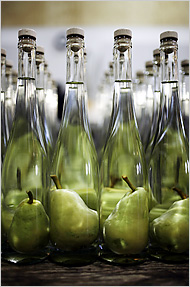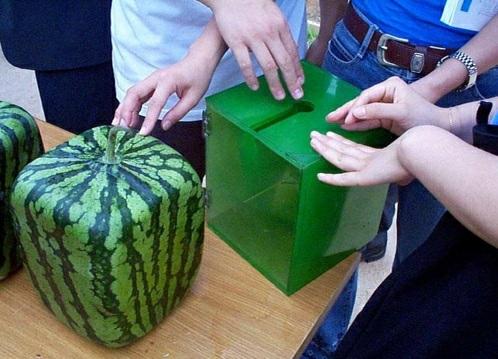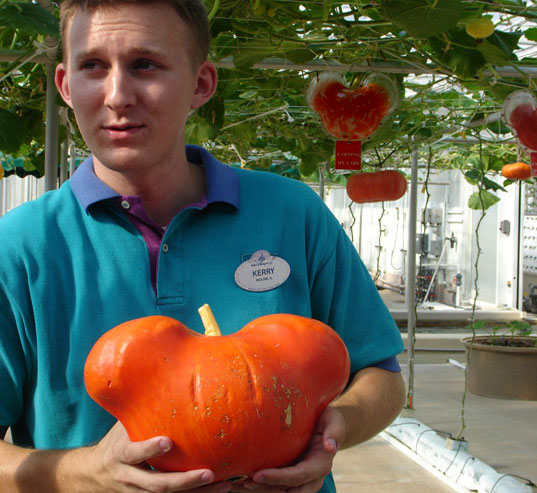We’ve all seen the odd-shaped fruit or veggie that might make a person with a “vivid” imagination giggle. While such organic aberrations are natural, gardeners have a long history of shaping produce to fit their needs – and their whims. Bonsai, the art of miniaturizing and shaping trees, goes back to at least 4000 BC. However, growing things like whole pears or peaches inside a bottle, square melons, exotically shaped cucumbers, and pumpkins that look like Mickey Mouse are more modern, and edible, examples of man’s efforts to manipulate nature.
Eau de vie or “water of life” is a type of brandy originally created by medieval monks who mashed surplus fruit and fermented and distilled it. It takes about 20 pounds of fruit to make one bottle of eau de vie, and the resulting spirit is high in alcohol and very clear, with only a hint of the flavor of the fruit it was made from. Some of the more expensive versions feature a whole pear or peach inside the relatively slim bottle. So how the heck do they do that? Well, they put the immature fruit inside the bottle while the fruit is still growing on the tree, wait until the fruit has grown to full size inside the bottle, remove the bottle containing the ripe fruit from the tree, and then add the appropriate brandy and age it. L’eau de poire, for example, is not only delicious, it’s a work of art.
The Dole Pineapple Corporation in Hawaii was less interested in aesthetics than in practicality when it came to putting their produce into containers. It began producing commercial, canned pineapple in 1903, using hand labor to peel, core, and pack the product into tin cans. The development of varieties of pineapples that, when ripe and processed, would fit a standard tin can was the first step in improving productivity, and, by the 1990s, canning machines, used to replace hand labor, could process up to 100 pineapples per minute.
The Japanese faced a somewhat similar problem with watermelons. Watermelons are big and round, and Japanese refrigerators (not to mention all their spaces) are small. The answer? Square watermelons. Since 1981, Japanese farmers have been growing square watermelons by inserting them into square, tempered glass cases while the fruits are still growing on the vine. The good news is that square watermelons take up a lot less space and, therefore, are easier to ship and store; the bad news is that they cost about three times more than the common garden variety.
In Britain, Tesco, the UK supermarket chain, began offering Brazilian-grown, square watermelons in 2006 at under $10, a far cry from the cost of about $80 each in Japan. Still, it can be argued that the Japanese square melons are “green,” insofar as they were designed to fit perfectly on the shelves of a typical Japanese refrigerator, and, because the cubic shapes require less room during shipping, it means fewer shipments are required, resulting in less fuel consumption and a smaller food mile number (the distance food travels from point of origin to point of consumption).
The examples above cover some valid aesthetic and commercial reasons for spatially challenging our fruits and veggies. But never underestimate the bottom line for either approach. Martha Stewart fans adore cucumbers whose slices resemble hearts or stars, pumpkin fanatics can now buy molds that make pumpkins end up with faces on them, and the greenhouse at Walt Disney’s Epcot theme park in Florida grows vegetables in the shape of, what else?, Mickey Mouse. It’s called supply and demand, whether or not it’s “sustainable.” Here’s to bio-geo-diversity – and human ingenuity.
Article by Bill Norrington





